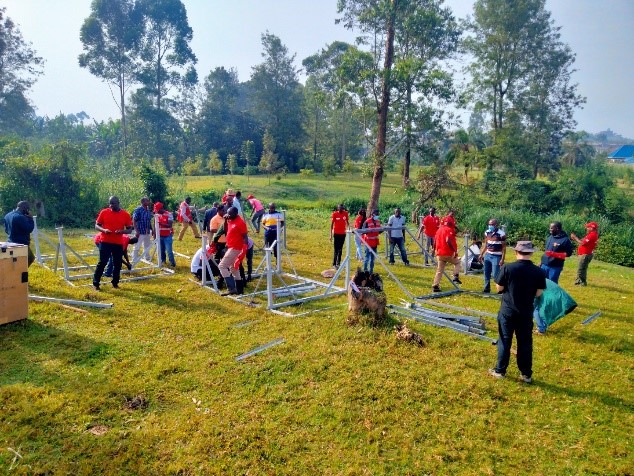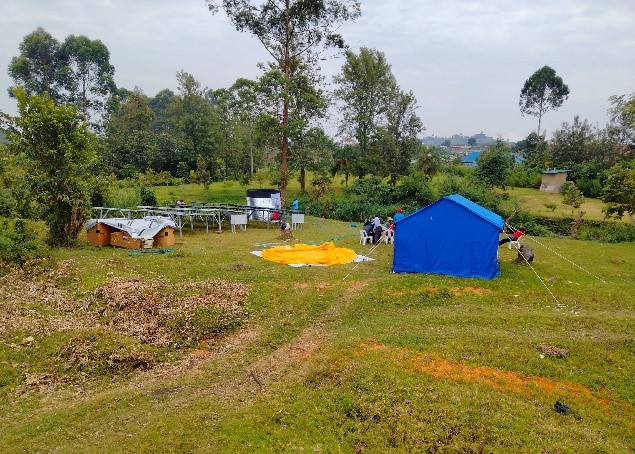Written by: Sylvester Bett- Austrian Red Cross Country Representative Uganda
1. The environment challenges
Global warming, carbon emissions and pollution of water & other natural resources are some of the phenomenon that have been attributed to climate change and other negative impacts on the environment we live in today. Although there are many causes of environmental pollution & degradation, use of fossil fuels is one of the main contributors as a result of the rapidly growing population which is demanding more & more energy to power the provision of goods & services that supports the good lifestyle we all desired. Fossil fuels have remained one of the most reliable, easy to use & easy to transport energy source, hence the world is extracting more and more fossil fuels in the form of Coal, petroleum and gas to support the ever growing hunger for energy. Humanitarian actors have not been left behind in this quest for more energy to support humanitarian action in the form of petroleum fuels for air transport, shipping, road transport & water supply pumping just to mention a few.
Through many global environmental forums and notably the series of the Convention Of the Parties(COP) to the United Nations Framework Convention on Climate Change (UNFCCC), where parties seek to agree on resolutions and frameworks that would guide sustainable development and adoption of renewable energy sources. As a follow up to these and other initiatives, the RCRC movement through the IFRC has adopted the green response approach to humanitarian actions with emphasis on the RCRC movement partners being encouraged to develop innovative approaches in the use of renewables to power humanitarian action.
2. The RCRC emergency response WASH tools
The RCRC has developed WASH kits that are used for deployment of WASH emergency response actions depending of the scale of the emergency needs. Some of this are; kit2, Kit5, the ERUs, MSM20, M40, HWTS, WSR (you may explore more details about the kits and their application on the IFRC go platform https://go.ifrc.org/deployments/catalogue/water). All these kits/units except for the kit2 & WSR are equipped with diesel or petrol powered water pumps that are the prime movers for the water delivery mechanism. This design offers a very flexible easy to move and deploy systems, which is the primary goal in any emergency response, especially in WASH where collapse of water supply systems have a potential to result in secondary catastrophe by eruption of water borne diseases e.g. cholera as was witnessed in Haiti during the earthquake crisis. As effective as these systems are they are normally one of the major contributors of carbon emissions and water body contaminations as a result of carbon dioxide from the engine operations, fuel and oil leaks that end up in the operating water sources, disposal of worn out parts and wrappers during servicing as well as noise pollution from the loud engine operations. There is therefore need to seek for innovations & technological advances that would transition these kits/units from reliance on petroleum products to renewable energy sources that will reduce the humanitarian response carbon footprint.
3. The kit 5 filter system to the kit 5 batch
The kit5 is the smallest unit equipped with the directly coupled petrol/diesel pumps and were originally designed to operate by employing the chemical aided water treatment system. The water is dosed in-line with chemical using flocculants tablets, then the flocculation occurs in a series of long pipes and the flocs are then removed by passing the water through a pressurised filter system after which disinfection and ultimate storage is done. These systems are effective in less turbid water and hence in Uganda where very turbid water is often the case in most river sources, the batch system which is employed by the ERUs was adopted.
This initial improvisation of the kit5 provided the best opportunity for solarisation of the kit since the unit is small enough to be used as a pilot and the batch system allows for a slow delivery of the required flow in one day hence smaller pumps could be employed which required fewer solar panels.

4. The solar age of the kit 5
The 1st initiative to solarise the system was started in 2021 under the HIP project funded by ECHO and implemented in Uganda by the URCS with technical support from the NLRC and the AutRC. In the consortium, AutRC provided lead in the WASH interventions which included emergency WASH trainings and the green response innovation which focused on the pilot solarisation of the kit5.

The new system design was undertaken by the AutRC EA Regional WASH delegates Sylvester Bett, Georg Ecker, Marco Skodak & the URCS WASH coordinator Grace Kygaba. Many option were initially considered and finally the team settled on the solarisation of the batch system. There were a number of changes in the system which included change of diesel pumps to electric pumps, design of the portable solar panel mounting system, design of the plug & play control unit and finally design of the packaging system for easy handling, transportation and safety of the equipment.
5. The solarised kit 5 training in fort portal
As part of ensuring that the new innovation can effectively be deployed in emergency situation the design team was also tasked with developing the training package and undertaking a pilot training using the new solarised system. This was a major challenge since the new innovation had to be 1st developed and tested, then followed by a training design and finally the actual training.
The solarised kit5 training was successfully undertaken from 6th to 10th march 2023. where a total of 24 participants were trained on the new kit. The training team lead by Sylvester Bett & George Ecker developed a training package which was focused at being practical and with maximum knowledge transfer. The participants were divided into two cohorts and the training was undertaken in tandem with the first cohort completing on 8th march 2023 in the morning and the 2nd cohort taking over immediately. There was a lot of learnings in the 1st cohort and this was transferred to the second cohort where the training was smoother. It was observed that the team of 11 participants was able to erect the solar array in 5 hrs and were able to deliver water within 10 hrs from start of the practical.
This was a remarkable achievement since in emergency response time is of essence and the new system was able to demonstrate that it can be set up within the 48/72 hr benchmarks in the sphere standards.


6. Achievements and learnings
The training was successful and achieved the planned learning outcomes and participants received knowledge on the solarised Kit5 also named the Kit5B/S meaning the (kit 5 batch solar). We have the confidence that majority of the trained teams are able to set up the system and use it in an operation.

7. Challenges
Being a new system and new training curriculum a lot was unclear and it was also learning by doing for all the team members and trainers. The kits also had to be corrected and improved in operation until the fine operation was achieved. Some learnings were taken and the system will be improved by re-supply of some components by the equipment supplier on warranty as well adoption of this into future variants of the same kit and training.
8. Future of the Kit5B/S
Green is the future:- hence the Kit5B/S is very timely in adopting the changing global technological changes. It is expected that with the continues improvements and innovation in green energy sources and storage the kit 5B/S will leverage on these developments to jump to the next level. We hope to see the kit 5 operating with 100% renewable energy and delivering clean carbon free water for disaster affected populations in displacement situations.
